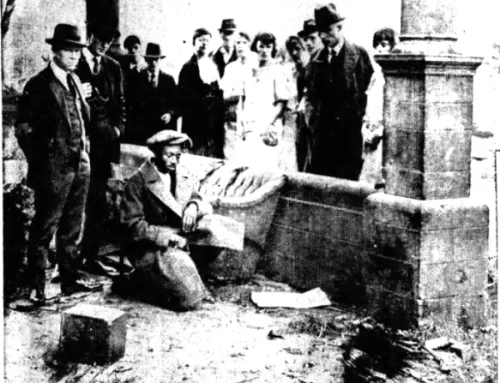“The Sustainable Square Mile was born to be in Black communities everywhere. So, our vision at Blacks in Green is self-sustaining Black communities everywhere.”
By Audrey Henderson
The holistic village-building vision of Blacks in Green, founded in 2007 in the West Woodlawn community on Chicago’s South Side includes eight essential principles that drive the work and vision of its founder Naomi Davis: wealth, energy, products, homestead, culture, organization, education and economy. For Davis, these principles are summed up in a mantra: a walk-to-work, walk-to-shop, walk-to learn, walk-to-play community where African Americans own the land, own the businesses and live the conservation lifestyle.
“We’re clear that our mission is about offering what we believe is a whole system solution for the whole system problem common in Black communities everywhere… Because [you know] what, we’re not just building housing, although building housing is functionally critical. We’re not just doing any one thing because we’re saying only a whole system solution can transform the whole system problem common of Black communities everywhere,” Davis said.
To that end, Blacks in Green manages the Black Chicago Water Council, which strives to ensure access to safe, clean and affordable water for all Black Chicagoans. BIG is also a contributing partner for the City of Chicago Climate Action Plan and an active partner in the development and execution of We Will Chicago, first city-wide master plan in more than seven decades.
Blacks in Green is also a founding member of the Coalition of House Museums, devoted to preserving and restoring structures related to prominent African Americans in Chicago, including the Emmett Till-Mobley House Museum, the Muddy Waters Original Jam Out Museum (MOJO); the Phyllis Wheatley House; The Elijah Muhammad House (also known as the Sajdah House), and the A. Philip Randolph Pullman Porter Museum. Blacks in Green purchased the Till-Mobley home in 2020, which obtained Chicago landmark status in 2021.
The Sustainable Square Mile in Chicago
The Sustainable Square Mile in Chicago is a wedge-shaped parcel bounded on the north by 61st Street, on the east by Cottage Grove Avenue, on the west by King Drive and on the south by the diagonal of South Cottage Grove Avenue where it intersects King Drive on 67th Street and Cottage Grove on 71st Street. The world-famous DuSable Museum of African American History and the Obama Presidential Center, presently under construction, are both located nearby.
Within its boundaries, the Sustainable Square Mile includes an assortment of moving parts: the Green Living Room, the Guest House next door, and a network of working gardens, including an urban arboretum in development. The BIG Green Homestead Development, a sustainable and energy efficient affordable housing complex designed by the late Michael Sorkin, is also in the planning stages.
“The Sustainable Square Mile was born to be in Black communities everywhere. So, our vision at Blacks in Green is self-sustaining Black communities everywhere. We started where we lived, of course, and with an intention to cultivate the practice so that we could be, not like a finished product, because we’re pretty far from that. But in terms of understanding our blueprint, we’re rock solid. It’s been basically the same for the sixteen years of our existence. And so, we have a firm idea of the whole system problem common to Black communities everywhere. We’re clear that our mission is about offering what we believe is a whole system solution for the whole system problem common in Black communities everywhere,” Davis said.
The development of the West Woodlawn Botanic Garden and Village Farm and Arboretum represents an especially prominent aspect of Davis’s vision of sustainable development for Blacks in Green. The development of the arboretum and other smaller green spaces within the Sustainable Square Mile has been an ongoing process which has spent years in development.
In July 2017, Blacks in Green coordinated with the Morton Arboretum, located in Niles, Illinois to conduct an inventory of the tree canopy within a small section of the designated arboretum area. A group of approximately 30 volunteers, accompanied by staff members from Blacks in Green and Morton Arboretum, numbered and categorized the variety of tree species, along with gauging the approximate age and health of the trees. Results from the inventory were analyzed to develop strategies to improve the neighborhood tree canopy – emphasizing species resistant to the destructive Emerald Ash Borer, while decreasing the prevalence of the ironically named – and invasive – Tree of Heaven, which is common in urban areas.
In mid-June 2023, Blacks in Green and the Delta Institute conducted a BioBlitz of five sites within the Sustainable Square Mile designated to be cultivated as green infrastructure, in conjunction with a special Juneteenth celebration. Much as with the 2017 tree inventory, volunteers worked alongside staff members from Blacks in Green and the Delta Institute to observe and categorize various plant, bird and pollinator insect species present within each of the designated observation areas, all located within short walking distances of one another. Four of the five sites are vacant and largely overgrown – for now.
“We’re in for penny and for a pound. We’re not going anywhere. And we’re seriously committed to a vision that we have for extraordinary beauty in the hood,” Davis said.
Indeed, the fifth site surveyed, the Emmett and Mamie Till-Mobley Forgiveness Garden, has grown lush and green since being plotted and planted in 2021. The Till Garden and the Arboretum each defy the conventional model of large plots of contiguous green enclaves separated from the urban grid. For Trinity Pierce, Stewardship Coordinator for the Chicago Region Trees Initiative at the Morton Arboretum, this divergence is beneficial rather than detrimental – enhancing the accessibility of these green spaces while reflecting the realities of its inhabitants and their community.
“I think oftentimes conservation organizations [that] are those focused on enriching the urban forest or tree health can lose sight of the people component. And I think this garden puts the needs of people. (It reflects) our history of racial injustice; makes it something that’s not buried, but you’re not being confronted or in a way that might shut other people down. So, I think it’s just a wonderful space for ongoing dialogue and conversation,” Pierce told Belt Magazine in November 2021.
The Green Living Room, the Guest House and the Till-Mobley House Museum
Located just south of 63rd Street on Cottage Grove, the Green Living Room serves as the hub for Blacks in Green and the various elements of the Sustainable Square Mile. Part performance stage, part homey sitting room (with catering and an open bar), part conference and lecture facility available to rent for meetings and social events – the various functions of the Green Living Room belie the red brick exterior that blends nearly inconspicuously into its surroundings near the corner of 63rd Street and South Cottage Grove Avenue.
The monthly Distinguished Lecture Series is a highlight of programming at the Green Living Room and features notable speakers relevant to the mission of Blacks in Green. Past guests have included former City of Chicago Department of Planning Commissioner Maurice Cox, Director of Disaster Services at Feeding America Vincent Davis, Managing Member of Bronzeville Partners LLC Paula Robinson and Chevy Humphrey, President and CEO of the Museum of Science and Industry in Chicago.
In July 2023, a special edition of the Distinguished Lecture Series boasted an ice cream social birthday celebration in honor of Emmett Till, who was lynched by White racists in 1955 when he was 14 years old. Unlike other events in the lecture series, it was held next door to the now vacant home of Mamie and Emmett Till, and featured an unveiling of a specially commissioned artwork titled “Be Careful, I Always Am” by internationally renowned architect and Chicago West Side native Germane Barnes, along with a presentation by Barnes. The installation represents symbolic protection of the home during its restoration and is scheduled to remain on site until the anniversary of Mamie Till-Mobley’s birthday in November 2023.
“It [the installation] really is just based off of a mother’s care for her son… the idea is that that’s a support structure that [provides] that guidance that we receive by those who mean so much to us, structures us, it supports us, it keeps us safe. And so, the primary portion of the installation is this massive scaffold system that surrounds the house. So, the scaffold sort of acts as Mamie’s protection of it, or in my case, my mother’s protection of me,” Barnes said.
In July 2022, Blacks in Green received $150,000 from the African American Cultural Heritage Action Fund, a project of the National Trust for Historic Preservation. The plan is to restore the Till-Mobley home to become a house museum, with tentative plans to open in 2025, when the Obama Presidential Center is also due to open. The first floor will be a gathering space devoted to community-building activities while its second floor will be restored to resemble how it appeared when Emmett embarked on his tragically ill-fated trip to Mississippi.
Next door to the Green Living Room, the Guest House manifests the Blacks In Green principle of economy. Davis envisions the Guest House to be a destination for visitors to the Obama Center and other sites within and near the Sustainable Square Mile. According to the Blacks in Green website, the Guest House was inspired by the legacy of the Negro Green Book, which listed accommodations in the South willing to house African Americans during the Jim Crow era.
Expanding the Sustainable Square Mile Model Nationwide
And now – even with most of its work still in progress, Blacks in Green has set out to expand the Sustainable Square Mile beyond West Woodlawn and beyond the city of Chicago. Tentative plans are presently in the works to establish locally-based manifestations in Boston, Baltimore, Miami and Dallas, using the existing Chicago manifestation as a rough template suitable for adaptation to address the specific issues of relevant communities.
While collaborations between Blacks in Green with other cities are still under development, Environmental Health Watch has already begun to implement its own version of the Sustainable Square Mile in the Buckeye neighborhood of Cleveland. Kim Foreman, Executive Director of Environmental Health Watch, is excited about collaborating with Blacks in Green to enhance its work in advancing environmental health through promoting healthy homes, healthy people and healthy communities. Foreman first interacted with Davis and Blacks in Green while developing a two-year EPA project.
“I decided in 2009 or 2010 to seek information from communities of color in Cleveland around what they thought sustainability was. At that time, I was seeking people of color in the nation that were familiar with the language and the work, and how they were working on sustainability — to introduce people to my community that that could resonate with them, so to speak. So that’s how I was first introduced to Blacks in Green.,” Foreman said.
And in 2019, after meeting Davis during a sustainability conference in Cleveland where Davis was a keynote speaker, Foreman determined that the Sustainable Square Mile Model could be a good fit for her organization and community.
“They asked me to introduce her, so that’s when I actually met her in person. I took her on a tour of the city of Cleveland and some of the people who I partnered with, so she could see Cleveland another way. Then I came to Chicago a few times and just started to see the evolution of Blacks in Green over the years,” Foreman said.
In March 2023, Foreman headed a delegation that participated along with Blacks in Green in a concurrent session of posters and information tables during a concurrent session of the Woodlawn Community Summit. Foreman and other colleagues from Environmental Health Watch made a subsequent trip to Chicago in May 2023 for a series of intensive sessions with Davis and Blacks in Green – with plans for a cohort from Blacks in Green to travel to Cleveland in September 2023, according to Davis.
The holistic and stakeholder-based approach of the Sustainable Square Mile model appeals to Foreman, who is seeking to establish a collaboration with Blacks in Green that works as a partnership, even as Environmental Health watch endeavors to incorporate and adapt the Sustainable Square Mile model to address the specific needs of the Buckeye community. She is determined to avoid the top-down approach that relegates stakeholders to spectator status that so often defines community development – especially where donor dollars are involved.
“We have a food co-op development team of stakeholders and residents. The residents have to make up 50% of that planning steering committee. And my goal was to say, okay, residents, the [administrators] tell you what their plans are. You check off a box or you say, I like the tile color. And that’s all you get when all of these plans have been crafted and developed for years [without stakeholder input]. But I’m trying to show [that] you have to be at the table to further develop the solution. Don’t be afraid to develop the relationships or understand where some of their constraints are,” Foreman said.
Looking Forward
Blacks in Green gained a major boost toward expanding its Sustainable Square Mile model in the form of a five-year, $10 million grant from the U.S. Environmental Protection Agency, administered through the Federal Interagency Communities Technical Assistance Network in April 2023 as part of the Justice 40 Initiative of the Biden-Harris administration. As one of 17 organizations selected to receive a slice of the $177 million pie, Blacks in Green will serve as lead for Region 5 of the EPA, which encompasses 35 tribal lands along with the states of Illinois, Indiana, Michigan, Minnesota, Ohio and Wisconsin.
In contrast to a more conventional model where smaller BIPOC organizations serve as subcontractors to a larger majority-White organization, Blacks in Green will act as the lead to a collaboration of five community-based organizations: the Midwest Tribal Energy Resources Association, Black Environmental Leaders Association, Environmental Health Watch, the School of Public Health at the University of Illinois Chicago, and the Smart Energy Design Assistance Center at the University of Illinois at Urbana-Champaign.
Recognition and financial support have only accelerated Davis’s sense of urgency toward furthering the mission of Blacks in Green to increase the well-being of BIPOC communities across the country, as opposed to than waiting until West Woodlawn has accomplished its revitalization – a process that could require decades of time, not to mention billions of dollars.
“All along it’s been our goal to have Sustainable Square Mile developments in every Black neighborhood across the country. Why? Because in 50 years of my witness as a child of the civil rights movement, I was born the day before Emmett [Till] was killed. And the arc, when we had all of the cash flows, we had the organizing, we had the ear of the world, we had the moral high ground, we had all of that in place. And across 50 years, our metrics of health and wealth are worse than ever. We didn’t manage the metric that mattered the most. And that is increase in household income.
“We’re saying let’s make the proof of concept be that we’re able to take the eight principles, programs, projects, activities and the employment, the enterprises associated with that. And over time, with a control group, with a methodology, with some metrics to implement the eight principles and thereby increase household income of legacy residents in these neighborhoods. Because if we don’t have that, it’s pointless,” Davis said.
Audrey is an independent writer and researcher based in the greater Chicago area with advanced degrees in sociology and law from Northwestern University. She specializes in sustainability in the built environment, culture and arts, policy, and related topics. Her work has been featured in Wallpaper magazine, the Chicago Reader, Chicago Architect magazine, Next City, Transitions Abroad, Belt Magazine and other consumer and trade publications. Her coverage focuses on environmental justice and equity.






